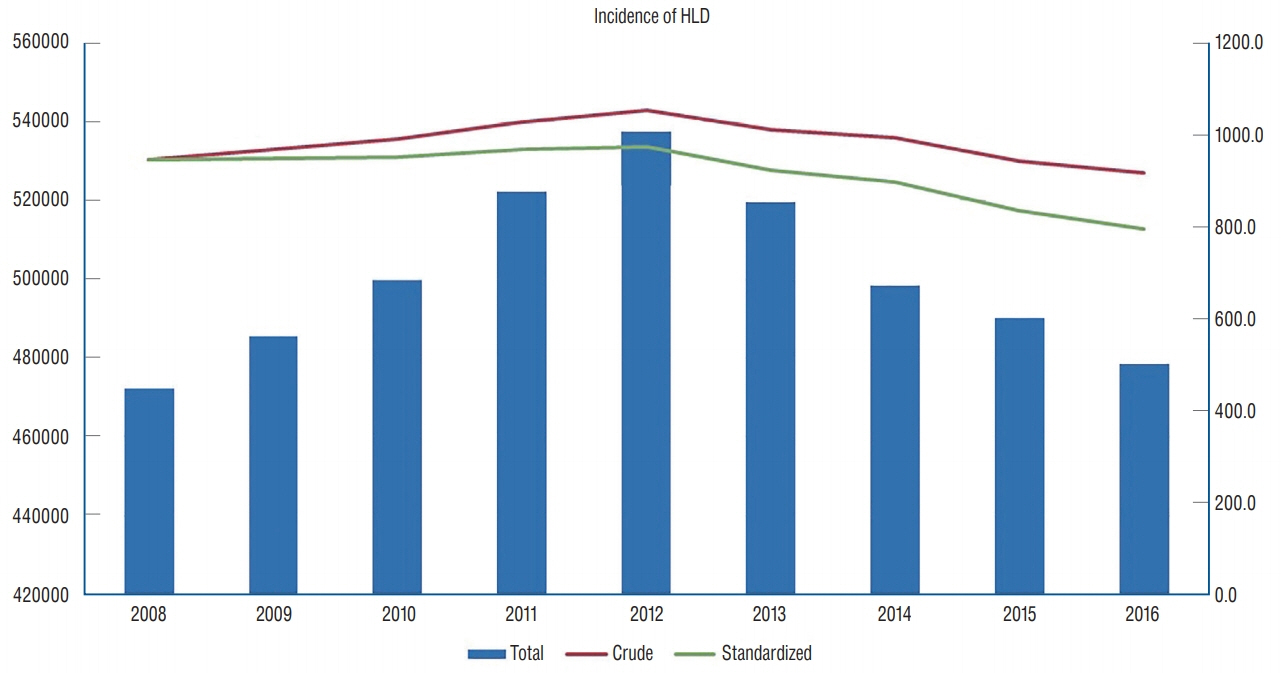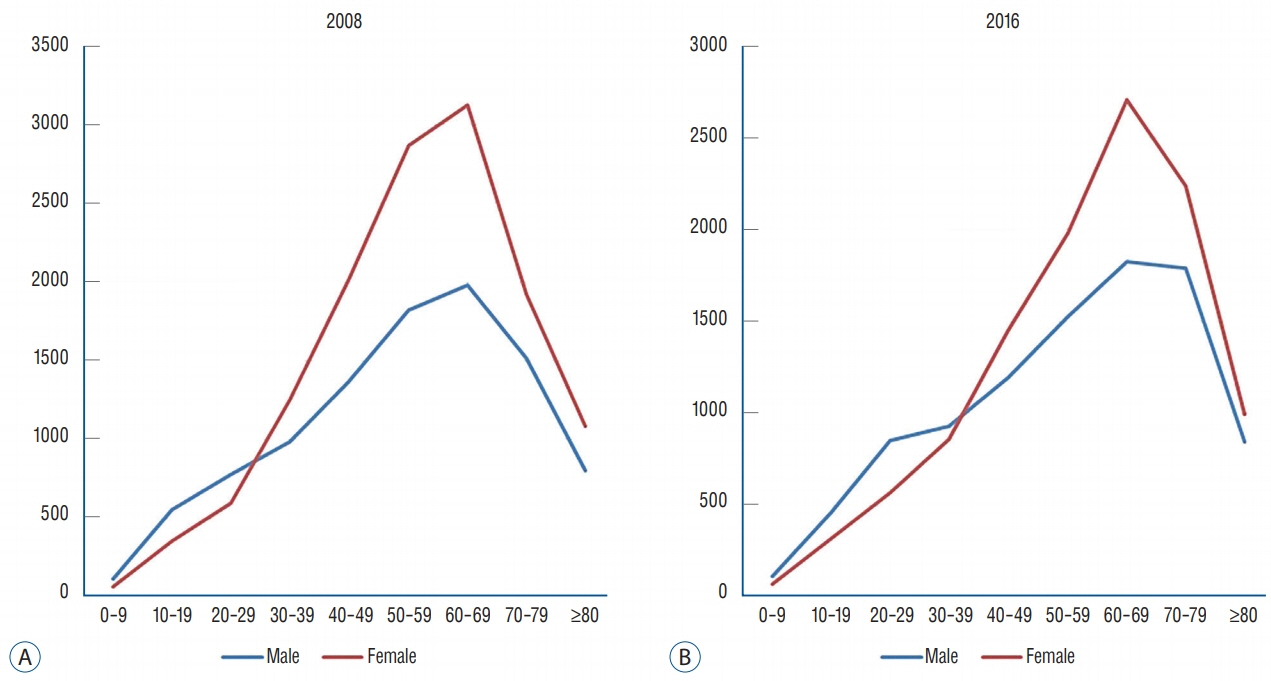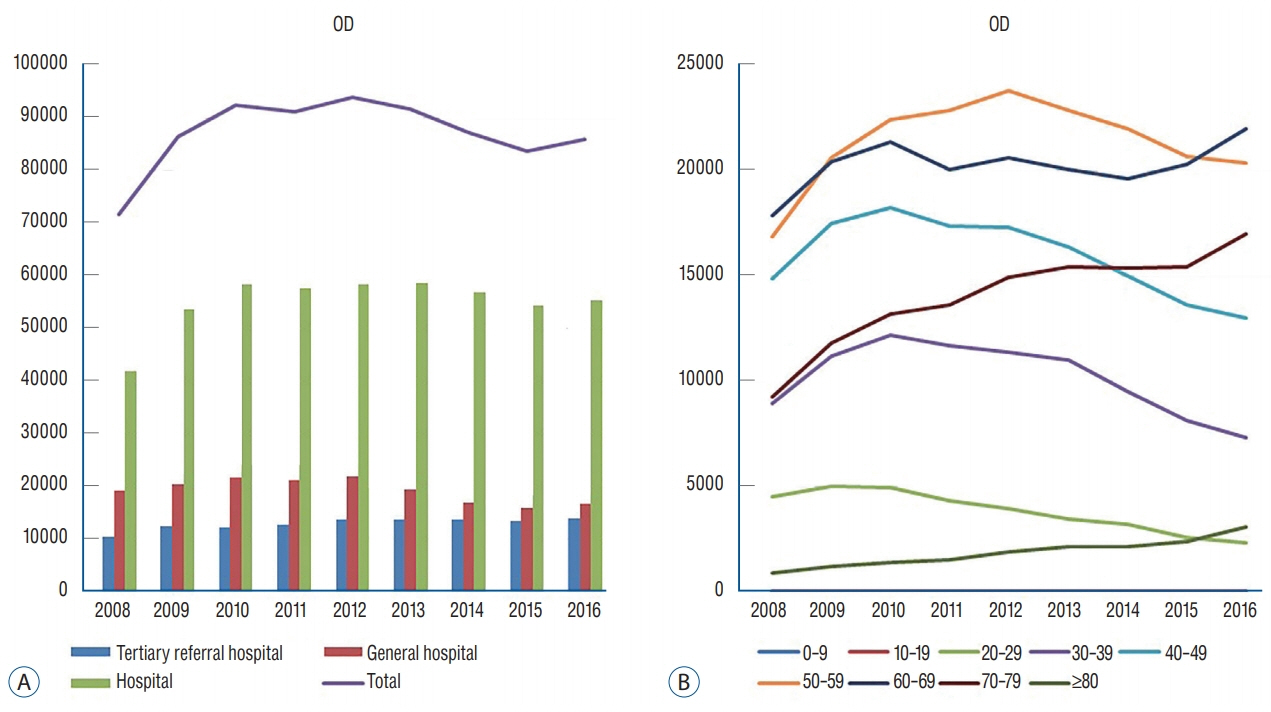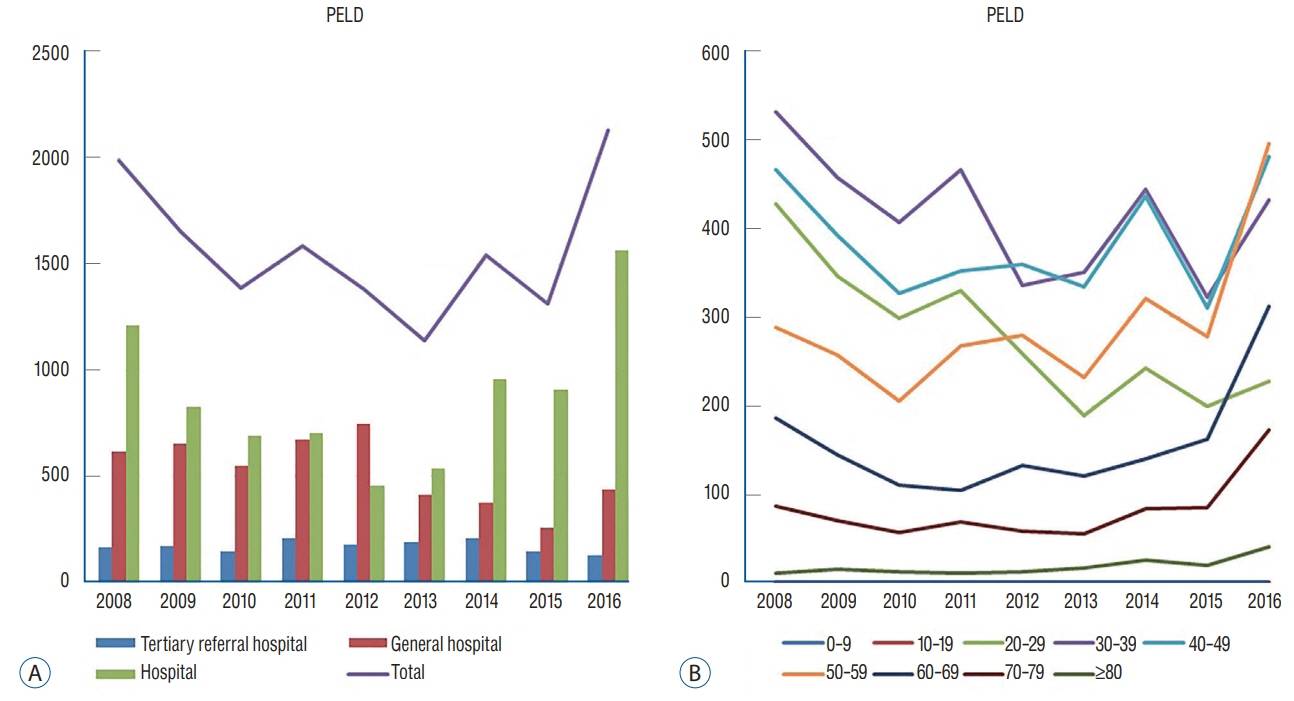J Korean Neurosurg Soc.
2020 Jan;63(1):108-118. 10.3340/jkns.2019.0075.
Trends in Incidence and Treatment of Herniated Lumbar Disc in Republic of Korea : A Nationwide Database Study
- Affiliations
-
- 1Department of Neurosurgery, Seoul National University Bundang Hospital, Seoul National University College of Medicine, Seongnam, Korea
- KMID: 2501698
- DOI: http://doi.org/10.3340/jkns.2019.0075
Abstract
Objective
: This study aimed to determine the incidence and analyze trends of the herniated lumbar disc (HLD) based on a national database in the Republic of Korea (ROK) from January 2008 to December 2016.
Methods
: This study was a retrospective analysis of data obtained from the national health-claim database provided by the National Health Insurance Service for 2008–2016 using the International Classification of Diseases. The crude incidence and age-standardized incidence of HLD were calculated, and additional analysis was conducted according to age and sex. Changes in trends in treatment methods and some treatments were analyzed using the Korean Classification of Diseases procedure codes.
Results
: The number of patients diagnosed with HLD was 472245 in 2008 and increased to 537577 in 2012; however, it decreased to 478697 in 2016. The pattern of crude incidence and the standardized incidence were also similar. Overall, the incidence of HLD increased annually for the 30s, 40s, 50s, and 70s until 2012 and then decreased. However, the incidence of HLD for the 80s continued to increase. The crude incidence of HLD in female patients exceeded that of male patients in their middle age (30s or 40s) and was 1.5–1.6 times higher than in male patients in their 60s. The total number of open discectomy (OD) increased from 71598 in 2008 to 93942 in 2012 and then decreased to 85846 in 2016. The rate of younger patients (the 20s, 30s, and 40s) who underwent OD was decreased, and the rate of younger patients who underwent percutaneous endoscopic lumbar discectomy was increased. However, the rate of older patients (the 70s and 80s) who underwent OD was continuously increased.
Conclusion
: This nationwide data on HLD from 2008 to 2016 in the ROK demonstrated that the crude incidence and the standardized incidence increased until 2012 and then decreased. The annual crude incidence was different according to age and sex. These findings may be considered when deciding future health policy, especially in countries with a similar national health insurance system (or with plans to adopt).
Keyword
Figure
Cited by 1 articles
-
A Prospective Observational Study of Return to Work after Single Level Lumbar Discectomy
Suk-Hyung Kang, Jin Seo Yang, Steve Sungwon Cho, Yong-Jun Cho, Jin Pyeong Jeon, Hyuk Jai Choi
J Korean Neurosurg Soc. 2020;63(6):806-813. doi: 10.3340/jkns.2020.0227.
Reference
-
References
1. Bailey JF, Sparrey CJ, Been E, Kramer PA. Morphological and postural sexual dimorphism of the lumbar spine facilitates greater lordosis in females. J Anat. 229:82–91. 2016.
Article2. Boden SD, Davis DO, Dina TS, Patronas NJ, Wiesel SW. Abnormal magnetic-resonance scans of the lumbar spine in asymptomatic subjects. A prospective investigation. J Bone Joint Surg Am. 72:403–408. 1990.
Article3. Campbell PG, Malone J, Yadla S, Chitale R, Nasser R, Maltenfort MG, et al. Comparison of ICD-9-based, retrospective, and prospective assessments of perioperative complications: assessment of accuracy in reporting. J Neurosurg Spine. 14:16–22. 2011.
Article4. Carragee EJ, Han MY, Suen PW, Kim D. Clinical outcomes after lumbar discectomy for sciatica: the effects of fragment type and anular competence. J Bone Joint Surg Am. 85:102–108. 2003.5. Cinotti G, Roysam GS, Eisenstein SM, Postacchini F. Ipsilateral recurrent lumbar disc herniation. A prospective, controlled study. J Bone Joint Surg Br. 80:825–832. 1998.6. Deyo RA, Mirza SK. Trends and variations in the use of spine surgery. Clin Orthop Relat Res. 443:139–146. 2006.
Article7. Deyo RA, Mirza SK. Clinical practice. Herniated lumbar intervertebral disk. N Engl J Med. 374:1763–1772. 2016.8. Deyo RA, Mirza SK, Martin BI, Kreuter W, Goodman DC, Jarvik JG. Trends, major medical complications, and charges associated with surgery for lumbar spinal stenosis in older adults. JAMA. 303:1259–1265. 2010.
Article9. Deyo RA, Taylor VM, Diehr P, Conrad D, Cherkin DC, Ciol M, et al. Analysis of automated administrative and survey databases to study patterns and outcomes of care. Spine (Phila Pa 1976). 19(18 Suppl):2083S–2091S. 1994.
Article10. Friedly J, Standaert C, Chan L. Epidemiology of spine care: the back pain dilemma. Phys Med Rehabil Clin N Am. 21:659–677. 2010.
Article11. Gaston P, Marshall RW. Survival analysis is a better estimate of recurrent disc herniation. J Bone Joint Surg Br. 85:535–537. 2003.
Article12. Hansson E, Hansson T. The cost-utility of lumbar disc herniation surgery. Eur Spine J. 16:329–337. 2007.
Article13. Hussain M, Nasir S, Moed A, Murtaza G. Variations in practice patterns among neurosurgeons and orthopaedic surgeons in the management of spinal disorders. Asian Spine J. 5:208–212. 2011.
Article14. Jordan J, Konstantinou K, O’Dowd J. Herniated lumbar disc. BMJ Clin Evid. 2011:1118. 2011.15. Kim CH, Chung CK, Choi Y, Shin S, Kim MJ, Lee J, et al. The selection of open or percutaneous endoscopic lumbar discectomy according to an age cut-off point: nationwide cohort study. Spine (Phila Pa 1976). 40:E1063–E1070. 2015.16. Kim CH, Chung CK, Kim MJ, Choi Y, Kim MJ, Hahn S, et al. Increased volume of lumbar surgeries for herniated intervertebral disc disease and cost-effectiveness analysis: a nationwide cohort study. Spine (Phila Pa 1976). 43:585–593. 2018.
Article17. Kim CH, Chung CK, Park CS, Choi B, Hahn S, Kim MJ, et al. Reoperation rate after surgery for lumbar spinal stenosis without spondylolisthesis: a nationwide cohort study. Spine J. 13:1230–1237. 2013.
Article18. Kim CH, Chung CK, Park CS, Choi B, Kim MJ, Park BJ. Reoperation rate after surgery for lumbar herniated intervertebral disc disease: nationwide cohort study. Spine (Phila Pa 1976). 38:581–590. 2013.
Article19. Kim CH, Chung CK, Shin S, Choi BR, Kim MJ, Park BJ, et al. The relationship between diabetes and the reoperation rate after lumbar spinal surgery: a nationwide cohort study. Spine J. 15:866–874. 2015.
Article20. Kim JM, Lee SH, Ahn Y, Yoon DH, Lee CD, Lim ST. Recurrence after successful percutaneous endoscopic lumbar discectomy. Minim Invasive Neurosurg. 50:82–85. 2007.
Article21. Kim KH, Park EC, Hahm MI. The gap between physicians and the public in satisfaction with the National Health Insurance system in Korea. J Korean Med Sci. 27:579–585. 2012.
Article22. Laratta JL, Shillingford JN, Cohen-Tanugi SJ, Lombardi JM, Lenke LG, Riew KD, et al. Defining the “critical elements” for the most common procedures in spine surgery: a consensus of orthopedic and neurosurgical surgeons. Spine (Phila Pa 1976). 43:E531–E536. 2018.23. Lee CH, Chung CK, Kim CH, Kwon JW. Health care burden of spinal diseases in the Republic of Korea: analysis of a nationwide database from 2012 through 2016. Neurospine. 15:66–76. 2018.
Article24. Mabud T, Norden J, Veeravagu A, Swinney C, Cole T, McCutcheon BA, et al. Complications, readmissions, and revisions for spine procedures performed by orthopedic surgeons versus neurosurgeons: a retrospective, longitudinal study. Clin Spine Surg. 30:E1376–E1381. 2017.25. Marinelli NL, Haughton VM, Anderson PA. T2 relaxation times correlated with stage of lumbar intervertebral disk degeneration and patient age. AJNR Am J Neuroradiol. 31:1278–1282. 2010.
Article26. Martin BI, Franklin GM, Deyo RA, Wickizer TM, Lurie JD, Mirza SK. How do coverage policies influence practice patterns, safety, and cost of initial lumbar fusion surgery? A population-based comparison of workers’ compensation systems. Spine J. 14:1237–1246. 2014.
Article27. Martin BI, Mirza SK, Comstock BA, Gray DT, Kreuter W, Deyo RA. Are lumbar spine reoperation rates falling with greater use of fusion surgery and new surgical technology? Spine (Phila Pa 1976). 32:2119–2126. 2007.
Article28. Martin BI, Mirza SK, Comstock BA, Gray DT, Kreuter W, Deyo RA. Reoperation rates following lumbar spine surgery and the influence of spinal fusion procedures. Spine (Phila Pa 1976). 32:382–387. 2007.
Article29. Martin BI, Mirza SK, Flum DR, Wickizer TM, Heagerty PJ, Lenkoski AF, et al. Repeat surgery after lumbar decompression for herniated disc: the quality implications of hospital and surgeon variation. Spine J. 12:89–97. 2012.
Article30. Matsumoto M, Watanabe K, Hosogane N, Tsuji T, Ishii K, Nakamura M, et al. Recurrence of lumbar disc herniation after microendoscopic discectomy. J Neurol Surg A Cent Eur Neurosurg. 74:222–227. 2013.
Article31. McGirt MJ, Ambrossi GL, Datoo G, Sciubba DM, Witham TF, Wolinsky JP, et al. Recurrent disc herniation and long-term back pain after primary lumbar discectomy: review of outcomes reported for limited versus aggressive disc removal. Neurosurgery. 64:338–344. discussion 344-335. 2009.32. McGirt MJ, Eustacchio S, Varga P, Vilendecic M, Trummer M, Gorensek M, et al. A prospective cohort study of close interval computed tomography and magnetic resonance imaging after primary lumbar discectomy: factors associated with recurrent disc herniation and disc height loss. Spine (Phila Pa 1976). 34:2044–2051. 2009.
Article33. Miller ML, Wang MC. Accuracy of ICD-9-CM coding of cervical spine fractures: implications for research using administrative databases. Ann Adv Automot Med. 52:101–105. 2008.34. Morgan-Hough CV, Jones PW, Eisenstein SM. Primary and revision lumbar discectomy. A 16-year review from one centre. J Bone Joint Surg Br. 85:871–874. 2003.35. Neuhauser H, Ellert U, Ziese T. Chronic back pain in the general population in Germany 2002/2003: prevalence and highly affected population groups. Gesundheitswesen. 67:685–693. 2005.
Article36. Oh H, Boo S. Burns in South Korea: an analysis of nationwide data from the Health Insurance Review and Assessment Service. Burns. 42:675–681. 2016.
Article37. Park JK, Kim KS, Kim CB, Lee TY, Lee KS, Lee DH, et al. The accuracy of ICD codes for cerebrovascular diseases in medical insurance claims. Korean J Prev Med. 33:76–82. 2000.38. Pejrona M, Ristori G, Villafañe JH, Pregliasco FE, Berjano P. Does specialty matter? A survey on 176 Italian neurosurgeons and orthopedic spine surgeons confirms similar competency for common spinal conditions and supports multidisciplinary teams in comprehensive and complex spinal care. Spine J. 18:1498–1503. 2018.
Article39. Rasouli MR, Rahimi-Movaghar V, Shokraneh F, Moradi-Lakeh M, Chou R. Minimally invasive discectomy versus microdiscectomy/open discectomy for symptomatic lumbar disc herniation. Cochrane Database Syst Rev. (9):CD010328. 2014.
Article40. Ruetten S, Komp M, Merk H, Godolias G. Full-endoscopic interlaminar and transforaminal lumbar discectomy versus conventional microsurgical technique: a prospective, randomized, controlled study. Spine (Phila Pa 1976). 33:931–939. 2008.
Article41. Schofferman J, Reynolds J, Herzog R, Covington E, Dreyfuss P, O’Neill C. Failed back surgery: etiology and diagnostic evaluation. Spine J. 3:400–403. 2003.
Article42. Strömqvist F, Strömqvist B, Jönsson B, Karlsson MK. Inferior outcome of lumbar disc surgery in women due to inferior preoperative status: a prospective study in 11,237 patients. Spine (Phila Pa 1976). 41:1247–1252. 2016.
Article43. Suk KS, Lee HM, Moon SH, Kim NH. Recurrent lumbar disc herniation: results of operative management. Spine (Phila Pa 1976). 26:672–676. 2001.44. Tosteson AN, Skinner JS, Tosteson TD, Lurie JD, Andersson GB, Berven S, et al. The cost effectiveness of surgical versus nonoperative treatment for lumbar disc herniation over two years: evidence from the Spine Patient Outcomes Research Trial (SPORT). Spine (Phila Pa 1976). 33:2108–2115. 2008.
Article45. van den Hout WB, Peul WC, Koes BW, Brand R, Kievit J, Thomeer RT, et al. Prolonged conservative care versus early surgery in patients with sciatica from lumbar disc herniation: cost utility analysis alongside a randomised controlled trial. BMJ. 336:1351–1354. 2008.
Article46. Weinstein JN, Lurie JD, Tosteson TD, Skinner JS, Hanscom B, Tosteson AN, et al. Surgical vs nonoperative treatment for lumbar disk herniation: the Spine Patient Outcomes Research Trial (SPORT) observational cohort. JAMA. 296:2451–2459. 2006.
Article47. Weinstein JN, Lurie JD, Tosteson TD, Skinner JS, Hanscom B, Tosteson AN, et al. Surgical vs nonoperative treatment for lumbar disk herniation: the Spine Patient Outcomes Research Trial (SPORT) observational cohort. JAMA. 296:2441–2450. 2006.
Article48. Wera GD, Dean CL, Ahn UM, Marcus RE, Cassinelli EH, Bohlman HH, et al. Reherniation and failure after lumbar discectomy: a comparison of fragment excision alone versus subtotal discectomy. J Spinal Disord Tech. 21:316–319. 2008.
Article
- Full Text Links
- Actions
-
Cited
- CITED
-
- Close
- Share
- Similar articles
-
- The Spontaneous Resorption of Herniated Lumbar Disc: A case report
- Loss of Disc Height after Spontaneous Regression of a Herniated Lumbar Disc: A Case Report
- Comparison of the Results between Standard Discectomy and Microdiscectomy of the Herniated Lumbar Disc
- Effects of Decompression Therapy for the Treatment of a Herniated Lumbar Disc
- A Clinical Study of Herniated Lumbar Intervertebral Disc in Teenagers






